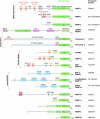The expanding field of poly(ADP-ribosyl)ation reactions. 'Protein Modifications: Beyond the Usual Suspects' Review Series
- PMID: 18927583
- PMCID: PMC2581850
- DOI: 10.1038/embor.2008.191
The expanding field of poly(ADP-ribosyl)ation reactions. 'Protein Modifications: Beyond the Usual Suspects' Review Series
Abstract
Poly(ADP-ribosyl)ation is a post-translational modification of proteins that is mediated by poly(ADP-ribose) polymerases (PARPs). Although the existence and nature of the nucleic acid-like molecule poly(ADP-ribose) (PAR) has been known for 40 years, understanding its biological functions--originally thought to be only the regulation of chromatin superstructure when DNA is broken--is still the subject of intense research. Here, we review the mechanisms controlling the biosynthesis of this complex macromolecule and some of its main biological functions, with an emphasis on the most recent advances and hypotheses that have developed in this rapidly growing field.
Figures



References
-
- Ahel I, Ahel D, Matsusaka T, Clark AJ, Pines J, Boulton SJ, West SC (2008) Poly(ADP-ribose)-binding zinc finger motifs in DNA repair/checkpoint proteins. Nature 451: 81–85 - PubMed
-
- Amé JC, Spenlehauer C, de Murcia G (2004) The PARP superfamily. Bioessays 26: 882–893 - PubMed
-
- Chang P, Jacobson MK, Mitchison TJ (2004) Poly(ADP-ribose) is required for spindle assembly and structure. Nature 432: 645–649 - PubMed
Publication types
MeSH terms
Substances
LinkOut - more resources
Full Text Sources
Other Literature Sources

